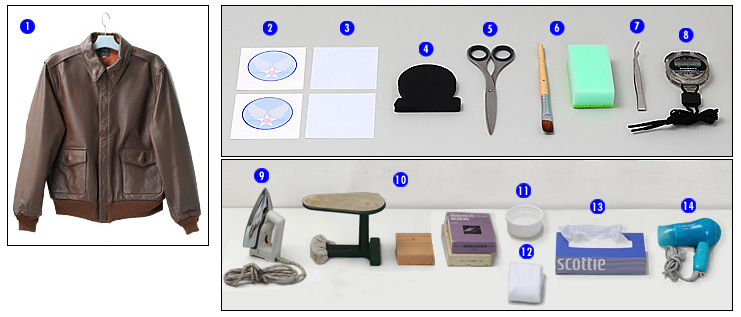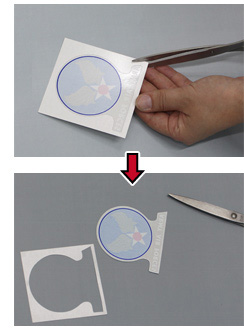· Please read this explanation carefully before your transcription.
Our New Model of AAF Decals for leather can be transcribed more easily and quickly than the classic style decal. However, things to note are more or less same as the classic style decal. There are many types of leather in the world, and different finishes as well, some of which may not fit our reproduction decals. We do not guarantee satisfactory with results without failure for all types of leather. Also, the decal is a very thin film. We do not guarantee the damage of decals during transfers or the loss of clothing caused by transcription errors. We sincerely hope that your decal transcription will be completed with satisfactory results without failure.
★ Requiremnt for Decals on A-2 & B-3
1) Leather garment for the transcription decal
2) New Model of Decal(4C) hopefully 2 pcs in case it fails
3) Release paper, should be attached with the decal
4) Rubber Board(1cm thick)
A developed Rubber Board which works very good for heat transcription 3" x 3" AAF Decals.
5) Scissors
6) Soft brush or Sponge
7) Tweezers
8) Stopwatch or Wrist watch with a second hand
9) Iron (No steam type)
10) Small ironing board or Wooden board/Books
11) Small tray or Cup with plain water
12) Soft cotton cloth
13) Tissue Paper
14) Electric Dryer
★ Decal - Full Colors Position for A-2 & B-3
1) Cut out the decal from Decal paper.
Cut out accurately 1mm outside of the transparent seal. This is to be placed the decal on top of the rubber board exactly, and also can prevent the square paper trace remains on the leather.
Note) Do not put the scissors into a transparent seal.
2) Set the jacket on top of the "Small ironing board".
3) Wipe lightly with a damp cloth to the leather surface of the transcription position.
Wipe lightly to dampen with a damp cloth to the wider surface than actual transcription surface. Then, warm the damp surface for 5 to 7 seconds by a electric dryer. The work to wipe with a damp cloth to leather surface of the transcription position has two meanings. The first purpose is for taking the dirt from the leather surface. Second purpose is for the transcription of the decal to more reliably by allowing wet the leather surface.
4) Place the Rubber Board on the "Small ironing board" under the sleeve top.
Positioning the Rubber Board at the correct position for the transcription. Please refer to the "Position for Decals on A-2 & B-3"
Note) Rubber Board was developed based on the advices of some artisans of leather craft. The purpose of the Rubber Board is to convey properly the heat and pressure of the iron only to the transcription surface. As a result, it works good for preventing traces of iron remaining on the leather.
5) Rewarm the surface of the leather which the rubber board is been positioning underneath.
Rewarm the correct transcription position for 5 to 7 seconds by a dryer.
6) Place the Decal in the correct position.
Placing the decal to the correct position while exploring the position of the rubber board with your fingertips over the leather.
Note-1) Upward the surface that has not been printed, place the print side down.
Note-2) A rubber board is designed about 5 mm bigger than a decal. Place the decal carefully to avoid the decal jut out from the rubber board.
7) Place a release paper on the decal and ironing over the release paper.
Temperature of ironing: about 130 degrees Celsius which is recommended for wool cloth.
Time of ironing: about for 12 to 13 seconds
Pressure of ironing: about 12 to 15 kg by small iron
Note-1 Do not move the iron while heating.
Note-2) If you use steam iron, make sure to turn off the steam switch and use the flat area with no hole of steam.
8) Remove the release paper and cool down naturally.
After the ironing, remove the release paper and cool down the decal naturally for 3 to 4 minutes.
9) Wet the back of mount of the decal using a brush or sponge.
After cooling down naturally, wet the back of mount of the decal using a brush or sponge until the entire design is seen through from the back of the mount.
Note)Sponge can be also used. But soft brush can wet the back of the mount of the decal without wetting much the leather of the peripheral decal.
10) Until wet the whole mount completely, left for about 1 minute.
The new decal is the type which is pasted on the mount with a water-soluble glue. Remove the mount from the transcribed decal on the leather by wetting the back of mount. After leaving the decal paper for one minute, try to move down the mount slightly with fingertips. And after confirming that the mount is distant from the decal, lift the lower end of the mount with the fingertips or tweezers, peel off slowly the entire mount from the decal.
Note) Do not try to move down the mount when feel the mount and decal still pasted each other. Repeat step 9).
11) Suck adhered water on the decal and the peripheral leather by a tissue paper.
Place a tissue paper lightly on the transcribed decal and suck adhering water on the decal and the peripheral leather.
Note) Do not press the tissue paper on the decal. The trace will remain on the decal.
12) Completed by blowing warm air in a dryer!!
The new decal is the type which is pasted on the mount with a water-soluble glue. Remove the mount from the transcribed decal on the leather by wetting the back of mount. After leaving the decal paper for one minute, try to move down the mount slightly with fingertips. And after confirming that the mount is distant from the decal, lift the lower end of the mount with the fingertips or tweezers, peel off slowly the entire mount from the decal.
Note) Do not try to move down the mount when feel the mount and decal still pasted each other. Repeat step 9).
13) Suck adhered water on the decal and the peripheral leather by a tissue paper.

Wear the jacket after keeping in a flat state without moving
more than 2 hours.
» Remove the failed decal after completely dry.
Failure is inherent to all works. Failed decal can be removed by rubbing your fingertips lightly at the edge of the decal so as not to damage the leather. One of the advantages of this decal is that the failed decal can be removed without much damages of leather.
Note) If hardly peeled, it might help peeling somewhat that rubbing with a small amount of water ahead of a fingertip or cotton swab.
How to transcribe Decal without Rubber Board
If you do not mind about the iron trace leaving at the surface of the leather after the transcription and do not expect better finish, the instruction shown below is for the transcription without Rubber Board.
Note) Step 1 to 3 are same as conventional procedures. Step 4 to 5 are no need to do for this method. Step 8 after that it is the same as conventional procedures. Different steps of 6 & 7 are only introduced as follows.
6-B) Place the Decal in the correct or desired position.
Refer to the "Position for Decals on A-2 & B-3". Place the Decal in the correct or desired position.
Note) Upward the surface that has not been printed, place the print side down.
7-B) Place a release paper on the decal and ironing over the release paper.
Place an release paper on the Decal and ironing with following conditions.
Temperature of ironing: about 130 degrees Celsius which is recommended for wool cloth.
Time of ironing: about for 12 to 13 seconds
Pressure of ironing: about 12 to 15 kg by small iron
Note-1) Use an larger release paper than the bottom of iron.
Note-2) Do not move the iron while heating.
Note-3) If you use steam iron, make sure to turn off the steam switch and use the flat area with no hole of steam.
★ Note of caution to use Leather Conditioner/Cleaner ★
Avoid using the Leather Conditioner/Cleaner to the decal surface and to the peripheral decal. Type of the tanning of the leather, the finish of the transcription, or by other factors, there's a possibility that the cause of early peeling of the decal. Please note.



















